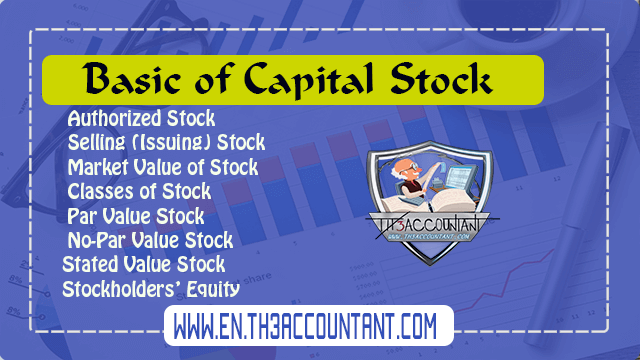Capital stock is a broad phrase that refers to any shares issued to raise funds (owner financing). This article defines capital stock terminology and accounting for it.
Capital Stock Fundamentals
Authorized Stock
The quantity of shares that a corporation's charter authorizes it to sell is referred to as authorized stock. The number of authorized shares frequently outnumbers the number of issued (and outstanding) shares, often by a substantial margin. (Issued stock owned by stockholders is referred to as outstanding stock.) Stock authorization does not necessitate a formal journal entry. If a corporation desires to issue more shares than previously permitted, it must petition to the state for a revision in its charter. In the equity portion of its balance sheet or notes, a corporation reveals the number of shares authorized.
Selling (Issuing) Stock
A corporation can sell shares in two ways: directly and indirectly. It advertises its stock issue to possible purchasers in order to sell directly. This is the most prevalent kind of issuance for privately held firms. A corporation pays a brokerage business (investment banker) to issue its shares in order to sell it indirectly. Some brokerage firms underwrite an indirect issue of shares, which means they acquire the stock from the business and take all profits or losses on resale.
Market Value of Stock
The price at which a stock is purchased and sold is known as its market value per share. Revenue, dividends, growth, and other corporate and economic factors all have an impact on market value. The market value of traded equities is published daily in newspapers such as The Wall Street Journal and online. The current market value of previously issued shares (for example, the price of stock in exchanges between investors) has no effect on the stockholders' equity of the issuing corporation.
Classes of Stock
The price at which a stock is purchased and sold is known as its market value per share. Revenue, dividends, growth, and other corporate and economic factors all have an impact on market value. The market value of traded equities is published daily in newspapers such as The Wall Street Journal and online. The current market value of previously issued shares (for example, the price of stock in exchanges between investors) has no effect on the stockholders' equity of the issuing corporation.
Par Value Stock
Par value stock is stock that has been allocated a par value, which is a fixed sum per share set by the corporation in its charter.
Palm's common stock, for example, has a par value of $0.001. Other typical par values are $10, $5, $1, and $0.01. The assigned par value is not limited in any way. The par value of a stock sets minimal legal capital in many states, which refers to the smallest amount that stock buyers must contribute to the business or be responsible to paying at a later period. In these states, the minimum legal capital for a corporation is $10,000 if it issues 1,000 shares of $10 par value stock. The purpose of minimum legal capital is to safeguard a corporation's creditors.Creditors' claims are restricted to the corporation's assets and any minimum legal capital since creditors cannot demand payment from stockholders' personal assets. Creditor claims are paid before any funds are transferred to stockholders during liquidation.
No-Par Value Stock
No-par value stock, or simply no-par stock, is stock that does not have a monetary value given to it per share by the company charter. Its benefit is that it may be issued at any price without the risk of a legal capital deficiency.
Stated Value Stock
Stated value stock is no-par stock that has a "stated" value per share assigned by the board of directors. In this circumstance, the stated value per share becomes the minimum legal capital per share.
Stockholders’ Equity
Stockholders' equity, also known as shareholders' equity or corporation capital, is the equity of a corporation. Exhibit 13.3 shows that stockholders' equity is made up of (1) paid-in (or contributed) capital and (2) retained earnings.
The entire amount of cash and other assets received by the corporation from its stockholders in return for its shares is referred to as paid-in capital. The cumulative net income (and loss) not dispersed as dividends to stockholders is referred to as retained earnings.
